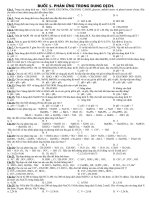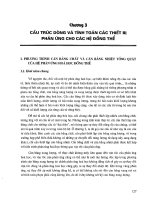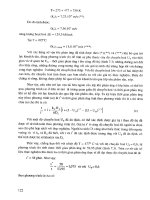Phản ứng trong ankin
Bạn đang xem bản rút gọn của tài liệu. Xem và tải ngay bản đầy đủ của tài liệu tại đây (5.12 MB, 37 trang )
Organic Chemistry
4
th
Edition
Paula Yurkanis Bruice
Chapter 6
Reactions
of
Alkynes
Introduction to
Multistep Synthesis
Irene Lee
Case Western Reserve University
Cleveland, OH
©2004, Prentice Hall
Alkynes are hydrocarbons that contain a carbon–carbon
triple bond
General formula: C
n
H
2n–2
(acyclic); C
n
H
2n–4
(cyclic)
Nomenclature
In common nomenclature, alkynes are named as
substituted acetylenes
CH
3
CHCHC
Cl Br
CCH
2
CH
2
CH
3
1 2 3 4 5 6 7 8
3-bromo-2-chloro-4-octyne
not 6-bromo-7-chloro-4-octyne
because 2 < 6
A substituent receives the lowest number if there is no
functional group suffix,
or if the same number for the functional group suffix is
obtained in both directions
CH
3
CHC
CH
3
CCH
2
CH
2
Br
123456
1-bromo-5-methyl-3-hexyne
not 6-bromo-2-methyl-3-hexyne
because 1 < 2
The Structure of Alkynes
A triple bond is composed of a σ bond and two π bonds
Addition Reactions of Alkynes
Sequential Addition of HCl
An alkyne is less reactive than an alkene
Relative Stabilities of Carbocations
Addition of Hydrogen Halides
In the presence of 1 mole equivalent of HBr
CH
3
CH
2
C CH
CH
3
CH
2
C
CH
H
Br
-
CH
3
CH
2
C
CH
H
Br
CH
3
CH
2
C
CH
H
CH
3
CH
2
CH CH
The secondary vinylic cation
is more stable
In the presence of excess HBr,
CH
3
CH
2
C
Br
CH
3
CH
3
CH
2
C
Br
CH
3
CH
3
CH
2
C
CH
2
Br
CH
3
CH
2
CCH
3
Br
Br
HBr
a carbocation is formed by adding the electrophile to the
sp
2
carbon bonded to the greater number of hydrogen
A secondary vinylic cation is about as stable as a primary
cation,
therefore a pi-complex may be the actual reaction
intermediate
HC CH
H
Cl
δ+
δ-
Many (but not all) alkyne addition reactions are
stereoselective
CH
3
CH
2
C CH CH
3
CH
2
CH CHBr
+ HBr
peroxide
Addition of Halogens to Alkynes
CH
3
CH
2
C CCH
3
CH
3
CH
2
C CCH
3
Cl
Cl
CH
3
CH
2
C CCH
3
Cl
Cl
Cl
Cl
Cl
2
CH
2
Cl
2
Cl
2
CH
2
Cl
2
CH
3
C CH CH
3
C CH
Br
Br
CH
3
C CCH
3
Br
Br Br
Br
Br
2
CH
2
Cl
2
Br
2
CH
2
Cl
2









